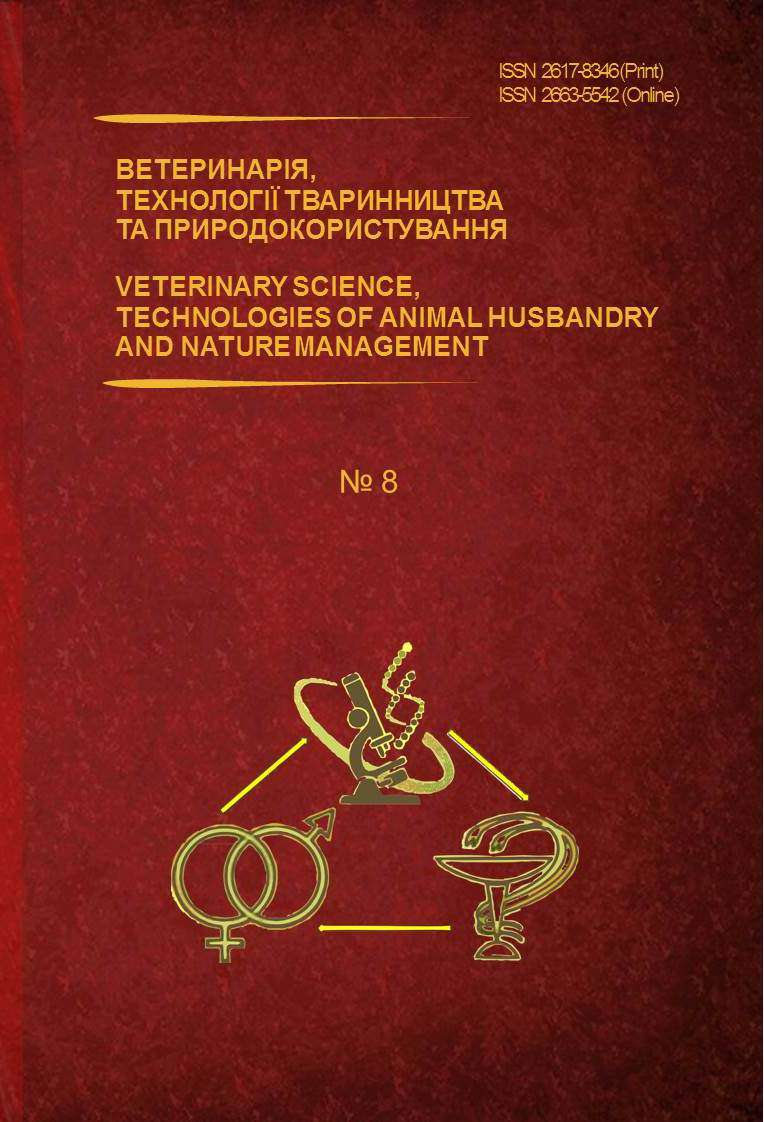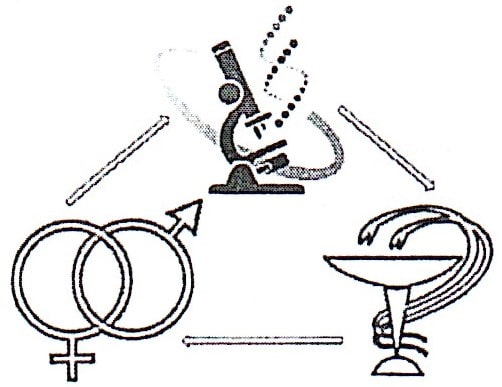Поведінка корів різного віку у період адаптації до умов добровільного доїння
Анотація
Метою цієї роботи було вивчити поведінку корів різного віку у лактаціях після зміни технології утримання та доїння. Дослідження проводили у ТДВ «Терезине» (Білоцерківський район, Київська область) на первістках (n=48) та коровах ІІ і ІІІ лактацій (n=86) української чорно-рябої молочної породи. Поголів’я корів ІІ і ІІІ лактацій утримувалось безприв’язно-боксово у приміщенні легкозбірного типу (ДхШхВ 100х36х10 м) на 300 голів, а нетелей – у капітальних, реконструйованих під безприв’язне утримання, приміщеннях та на вигульних майданчиках. Групу корів ІІ і ІІІ лактацій доїли у доїльному залі на установці «Паралель». Тварин обох груп через 10 діб після отелення було переведено на іншу ферму до легкозбірного приміщення на 400 голів (150х36х10,5 м) з добровільним доїнням на роботизованих установках VMS, розташованих на території приміщення. За нових умов утримання тварини різних вікових груп були розміщені у різні секції. Дослідження проводили упродовж адаптаційного періоду (30 діб після зміни умов утримання). Адаптаційний період було розділено на VI періодів тривалістю у 5 діб кожен. Добова поведінка групи первісток за основними показниками (лежання, ходьба, стояння і напування) відповідала значенням, котрі обумовлені графіком «ідеального» дня для молочних корів, починаючи з ІІІ періоду, а корів ІІ і ІІІ лактацій – лише у V періоді. За чотирма індексами (комфорту, стійловим, лягання, використання стійла), котрі характеризують комфорт корів при боксовому утриманні групи корів-первісток мали коротший термін адаптації до нових умов середовища. У групі первісток показник індексу комфорту відповідав нормі починаючи з ІІІ періоду, а індексу використання стійла – з ІV періоду. У корів ІІ і ІІІ лактацій вказані індекси відповідали регламентованим нормам, починаючи з ІV і V періодів відповідно. Група первісток продемонструвала вищі адаптаційні ознаки щодо тривалості поїдання кормів, порівняно з коровами ІІ і ІІІ лактацій. Тривалість поїдання корму у групі первісток відповідала рекомендованим значенням, починаючи з ІІ періоду (6-10 доба), а корів ІІ і ІІІ лактацій – починаючи з ІІІ періоду (11-15 доба). При проведенні етологічних досліджень під час процесу доїння первісток на роботі-автоматі встановлено, що упродовж адаптаційного періоду кількість спроб збити доїльний апарат під час доїння знизилась на 4,04 рази, а у групі корів ІІ і ІІІ лактацій на 4,39 разів.
Завантаження
Посилання
Bach, A., & Cabrera, V. (2017). Robotic milking: Feeding strategies and economic returns. Journal of dairy science, 100(9), 7720–7728. https://doi.org/10.3168/jds.2016-11694.
Borshch, O. O., Gutyj, B. V., Sobolev, O. I., Borshch, O. V., Ruban, S. Yu., Bilkevich, V. V., Dutka, V. R., Chernenko, O. M., Zhelavskyi, M. M., & Nahirniak, T. (2020). Adaptation strategy of different cow genotypes to the voluntary milking system. Ukrainian Journal of Ecology, 10(1), 145-150. https://doi.org/10.15421/2020_23.
Borshch, O. O., Ruban, S. Yu., & Borshch, O. V. (2021). The influence of genotypic and phenotypic factors on the comfort and welfare rates of cows during the period of global climate changes. Agraarteadus, 1, 25–34. https://doi.org/10.15159/jas.21.12.
Cook, N. B. (2007). The Dual Roles of Cow Comfort in the ‘Get Lame – Stay Lame’ Hypothesis. Sixth International Dairy Housing Conference Proceeding 16-18 June 2007, (Minneapolis, Minnesota, USA). ASABE, 701P0507e. http://dx.doi.org/10.13031/2013.22819.
Cook, N. B., Bennett, T. B., & Nordlund, K. V. (2005). Monitoring indices of cow comfort in free-stall-housed dairy herds. Journal of Dairy Science, 88, 3876–3885. https://doi.org/10.3168/jds.S0022-0302(05)73073-3.
Córdova, H. A., Alessio, D. R., Cardozo, L. L., & Neto, A. T. (2018). Impact of the factors of animal production and welfare on robotic milking frequency. Pesquisa Agropecuária Brasileira, 53 (2), 238–246. https://doi.org/10.1590/S0100-204X2018000200013.
Drach, U., Halachmi, I., Pnini, T., Izhaki, I., & Degani, A. (2017). Automatic herding reduces labour and increases milking frequency in robotic milking. Biosystems Engineering, 155, 134–141.https://doi.org/10.1016/j.biosystemseng.2016.12.010.
Hansen, B.G. (2015). Robotic milking-farmer experiences and adoption rate in Jæren, Norway. Journal of Rural Studies, 41, 109–117. http://dx.doi.org/10.1016%2Fj.jrurstud.2015.08.004.
Holloway, L., & Bear, C. (2019). Beyond resistance: geographies of divergent more-that-human coduct in robotic milking. Geoforum, 104, 212–221. https://doi.org/10.1016/j.geoforum.2019.04.030.
Holloway, L., Wilkinson, K., & Bear, C. (2014). Robotic milking technologies and renegotiating situated ethical relationships on UK dairy farms. Agriculture and Human Values, 31(2), 185–199. https://doi.org/10.1007/s10460-013-9473-3.
Jacobs, J. A., & Siegford, J. M. (2012). Lactating dairy cows adapt quickly to being milked by an automatic milking system. Journal of Dairy Science, 95, (3), 1575–1584. https://doi.org/10.3168/jds.2011-4710.
Krawczel, P. D., & Grant, R. J. (2009). Effects of Cow Comfort on Milk Quality, Productivity, and Behavior. Retrieved from https://www.afimilk.com/app/uploads/effects_of_cow_comfort_on_milk_quality_productivity_and_behavior.pdf.
Melin, M., Pettersson, G., Svennersten-Sjaunja, K., & Wiktorsson, H. (2007). The effects of restricted feed access and social rank on feeding behavior, ruminating and intake for cows managed in automated milking systems. Applied Animal Behaviour Science, 107(1), 13–21. https://doi.org/10.1016/j.applanim.2006.09.026.
Miguel-Pacheco, G. M., Kaler, J., Remnant, J., Cheyne, L., Abbott, C., French, A. P., Pridmore, T. P., & Huxley, J. N. (2014). Behavioural changes in dairy cows with lameness in an automatic milking system. Applied Animal Behaviour Science, 150, 1–8. https://doi.org/10.1016/j.applanim.2013.11.003.
Munksgaard, L., Rushen, J., de Passillé, A. M., & Krohn, C. C. (2011). Forced versus free traffic in an automated milking system. Livestock Science, 138, (1–3), 244–250. https://doi.org/10.1016/j.livsci.2010.12.023.
Overton, M. W., Sischo, W. M., Temple, G. H., & Moore, D. A. (2002). Using time-lapse video photography to assess dairy cattle lying behavior in a free-stall barn. Journal of Dairy Science, 85, 2407–2413. https://doi.org/10.3168/jds.S0022-0302(02)74323-3.
Pérez-Ramírez, E., Peyraud, J. L., & Delagarde, R. (2009). Restricting daily time at pasture at low and high pasture allowance: Effects on pasture intake and behavioral adaptation of lactating dairy cows. Journal of Dairy Science, 92, (7), 3331–3340. https://doi.org/ 10.3168/jds.2008-1951.
Piwczyński, D., Sitkowska, B., Kolenda, M., Brzozowski, M., Aerts, J., & Schork, P. M. (2020). Forecasting the milk yield of cows on farms equipped with automatic milking system with the use of decision trees. Animal Science Journal, 91, e13414. https://doi.org/10.1111/asj.13414.
Rousing, T., Badsberg, J. H., Klaas, I. C., Hindhede, J., & Sørensen, J. T. (2006). The association between fetching for milking and dairy cows' behaviour at milking, and avoidance of human approachdan on-farm study in herds with automatic milking systems. Livestock Science, 101(1), 219–227. https://doi.org/10.1016/j.livprodsci.2005.11.013.
Ruban, S., Borshch, O. O., Borshch, O.V., Orischuk, O., Balatskiy, Y., Fedorchenko, M., Kachan, A., & Zlochevskiy, M. (2020). The impact of high temperatures on respiration rate, breathing condition and productivity of dairy cows in different production systems. Animal Science Papers and Reports, 38(l), 61–72. Retrieved from https://www.cabdirect.org/cabdirect/abstract/20203167447.
Sitkowska, B., Piwczyński, D., Aerts, J., & Waśkowicz, M. (2015). Changes in milking parameters with robotic milking. Archive Animal Breeding, 58, 137–143. https://doi.org/10.5194/aab-58-137-2015.
Tucker, C. B., Weary, D. M. & Fraser, D. (2005). Influence of neck-rail placement on free-stall preference, use, and cleanliness. Journal of Dairy Science, 88, 2730–2737. https://doi.org/10.3168/jds.S0022-0302(05)72952-0.
Vijayakumar, M., Park, J. H., Ki, K. S., Lim, D. H., Kim, S. B., Park, S. M., Jeong, H. Y., Park, B. Y., & Kim, T. I. (2017). The effect of lactation number, stage, length, and milking frequency on milk yield in Korean Holstein dairy cows using automatic milking system. Asian-Australasian Journal of Animal Sciences, 30(8), 1093–1098. https://doi.org/10.5713/ajas.16.0882.
Переглядів анотації: 1179 Завантажень PDF: 647





